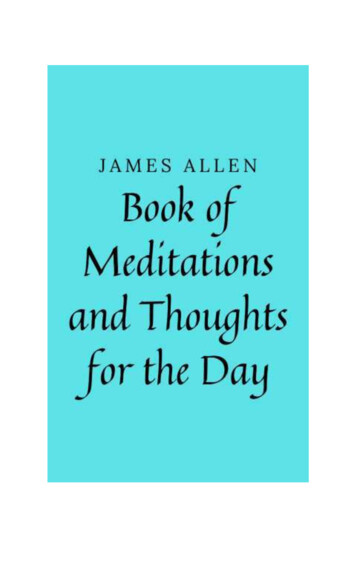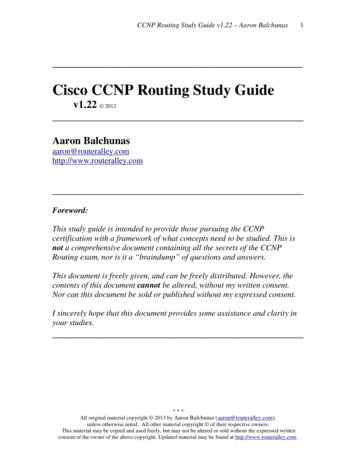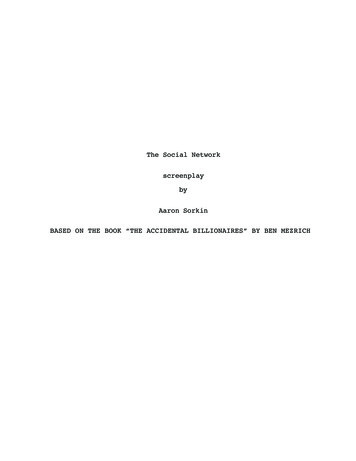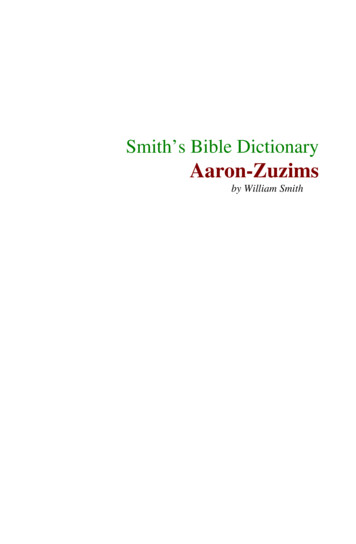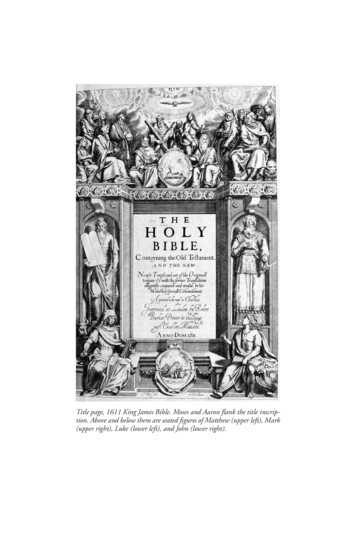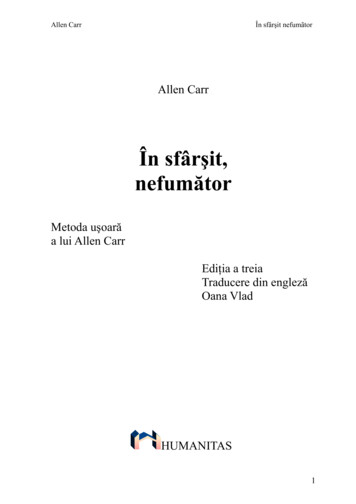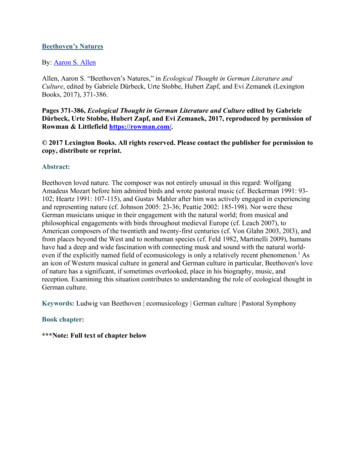
Transcription
Beethoven’s NaturesBy: Aaron S. AllenAllen, Aaron S. “Beethoven’s Natures,” in Ecological Thought in German Literature andCulture, edited by Gabriele Dürbeck, Urte Stobbe, Hubert Zapf, and Evi Zemanek (LexingtonBooks, 2017), 371-386.Pages 371-386, Ecological Thought in German Literature and Culture edited by GabrieleDürbeck, Urte Stobbe, Hubert Zapf, and Evi Zemanek, 2017, reproduced by permission ofRowman & Littlefield https://rowman.com/. 2017 Lexington Books. All rights reserved. Please contact the publisher for permission tocopy, distribute or reprint.Abstract:Beethoven loved nature. The composer was not entirely unusual in this regard: WolfgangAmadeus Mozart before him admired birds and wrote pastoral music (cf. Beckerman 1991: 93102; Heartz 1991: 107-115), and Gustav Mahler after him was actively engaged in experiencingand representing nature (cf. Johnson 2005: 23-36; Peattie 2002: 185-198). Nor were theseGerman musicians unique in their engagement with the natural world; from musical andphilosophical engagements with birds throughout medieval Europe (cf. Leach 2007), toAmerican composers of the twentieth and twenty-first centuries (cf. Von Glahn 2003, 20l3), andfrom places beyond the West and to nonhuman species (cf. Feld 1982, Martinelli 2009), humanshave had a deep and wide fascination with connecting musk and sound with the natural worldeven if the explicitly named field of ecomusicology is only a relatively recent phenomenon.1 Asan icon of Western musical culture in general and German culture in particular, Beethoven's loveof nature has a significant, if sometimes overlooked, place in his biography, music, andreception. Examining this situation contributes to understanding the role of ecological thought inGerman culture.Keywords: Ludwig van Beethoven ecomusicology German culture Pastoral SymphonyBook chapter:***Note: Full text of chapter below
Chapter 24Beethoven's NaturesAaron S. Allen1111II"'111'IHow fortunate you are to be able to go into the country so soon. Icannot enjoy this happiness until the 8th, but I look forward to it withchildish excitement. How delighted I shall be to ramble for a whilethrough bushes, woods, under trees, through grass and around rocks.No one can love the country as much as I do. For surely woods, trees,and rocks produce the echo which man desires to hear.-Ludwig van Beethoven to Therese Malfatti; MOdling,Vienna, May 1810Beethoven loved nature. The composer was not entirely unusual in thisregard: Wolfgang Amadeus Mozart before him admired birds and wrotepastoral music (cf. Beckerman 1991: 93-102; Heartz 1991: 107-115), andGustav Mahler after him was actively engaged in experiencing and representing nature (cf. Johnson 2005: 23-36; Peattie 2002: 185-198). Nor werethese German musicians unique in their engagement with the natural world;from musical and philosophical engagements with birds throughout medieval Europe (cf. Leach 2007), to American composers of the twentieth andtwenty-first centuries (cf. Von Glahn 2003, 20l3), and from places bey,ondthe West and to nonhuman species (cf. Feld 1982, Martinelli 2009), humanshave had a deep and wide fascination with connecting musk and sound withthe natural world-even if the explicitly named field of ecomusicologydsonly a relatively recent phenomenon. 1 As an icon of Western musical culturein &eneral and German culture in particular, Beethoven's love of nature hasa significant, if sometimes overlooked, place in his biography, music, andreception. Examining this situation contributes to understanding the role ofecological thought in German culture.371' [II·'.I
3721.,Aaron S. AllenIn smnmanzmg critical responses to Beethoven in the two centuriessince the composer's death, Scott Burnham articulated four ages of reception: Beethoven as romantic revolutionary hero (1827-1870), as spiritualand political redeemer (1870-1927), as lawgiver regarding classical values(1927-1970), and as cultural product and culturally constructed hero (after1970) (cf. Bumham"2000: 272-291). Eggebrecht found that the major themesin Beethoven reception (particularly of the nineteenth century) included thecomposer's suffering, striving, and overcoming (cf. Eggebrecht 1994).An important if curiously minor theme throughout this reception hasbeen Beethoven's well-known love of nature. Beethoven's frequent (andenjoyable) trips into the countryside out of Vienna and his reverence fornature are well-established facts. In his authoritative biography, LewisLockwood provided but a single sentence on the issue: "That [Beethoven]loved the countryside and relished taking excursions into the woods andfields is clear from biographical evidence of all kinds" (Lockwood 2003:225). In his encyclopedia about the composer, Netti wrote of Beethoven's"unusual love for nature" that manifested itself in what today we mightrefer to as the pastoral: "It is well known that Beethoven was an enthusias'tic nature-lover who took every opportunity to l ave the city. Dobling, Heiligenstadt, Baden, MOdling, and Nussdorf were his favorite spots, and heenjoyed the beauty of the Wiener Wald more than any other place" (Netti1956: 149). Beethoven's amanuensis and (not always trustworthy) biographer Anton Schindler described the composer: "In his fifty-fourth year hecould be entirely satisfied only by nature, and nature and his art alone wereable to hold him. People and houses seldom pleased him for both had toomany faults" (Schindler 1966: 381). And as Beethoven himself put it: "Itseems as if in the country every tree said to me 'Holy! Holy!'-Who cangive complete expression to the ecstasy of the woods?" (qtd. in Thayer1991: 501). 2Whence and whither Beethoven's love of nature? In this chapter I presenta panoramic understanding of Beethoven and nature based on his biography("The Nature of Beethoven"), music ("Beethoven's Nature"), and reception("Beethovenian Nature"). We can find the whence of Beethoven's love ofnature in his biography (particularly regarding his childhood and life-longstruggles), and we find the whither manifesting itself both in Beethoven'smusic and in the reception of his life and works. Beethoven loved nature andincorporated some ideas of nature into his music; lie has 'also been held up asan artist who had a significant connection to nature. Such an understanding ofhis life and music have shaped and impacted our very understanding of him,which have in tum promoted the connections between the idea of nature (asrepresentative of ecological thought) and German culture.I1
,Iu.·.,.··.·, :.,1.·Beethoven's Natures373THE NATURE OF.BEETHOVEN: BIOGRAPHYBeethoven came from a musical family of modest means. What in particularabout Beethoven's biography engendered his life-long love of nature? Thefollowing emphasizes just three biographical elements that impacted andreflect Beethoven's engagement with nature: his places and travels, personalstruggles, and markings in a book about nature.Born in Bonn in 1770, Beethoven moved in 1792 to Vienna, where heremained {with the exception of occasional travels) until his death in 1827.The owners of the Beethoven family home in Bonn reported that youngBeethoven loved the Rhine River, which he could see from the back of theirhouse. Furthermore, they reported that when Beethoven's musician fatherwas off duty because the Elector was away, he regularly took young Ludwiginto the countryside to places such as Rheinbach, Flamersheium, Ahrweiler,Hennef, Siegburg, Bensberg, and Oberkassel (cf. Thayer 1991: 62).Bonn was an important cultural city in the eighteenth century, but Viennawas the non plus ultra for musicians due to larger audiences and a greaterconcentration of wealthy patrons to support music. Its larger size and population combined with its summer heat were also reasons to escape the city. AsBeethoven wrote in 1813 to his patron Archduke Rudolf, "To stay in,townduring the summer is torture to me" (Anderson 1961: #429, 423). Beethovenchanged residences continually within Vienna, and he took lodgings justoutside the city every summer between 1800 and 1826. 3 Writing in 1801 tohis childhood friend Franz Wegeler, he said: "You will rent a house for me insome beautiful part of the country and then for six months I will lead the lifeof a peasant" (Anderson 1961: #51, 60). Today many of the villages whereBeethoven sojourned have been incorporated into the urban metropolis that isVienna; in the early nineteenth century, they were rural areas. Heiligenstadt,Hetzendorf, and MOdling were regular summer destinations for Beethoven,but his favorite spot was Baden bei Wien in the Wiener Wald, where hestayed over a dozen times. When Beethoven was unable to go to the countryside, he lamented; during the 1809 French occµpation of Vienna he wrote tohis publisher Breitkopf & Hartel that, "The whole course of events has in mycase affected both body and soul. I cannot yet give myself up to the enjoyment of country life which is so indispensable to me" (Anderson 1961: #220,234). Beethoven's working methods and daily schedule relied significantlyon nature: in and out of Vienna, rain or shine, he took long walks every day,during which he would contemplate the world and make compositional notes.As the artist August von KIOber recounted in 1818, "I encountered Beethovenseveral times on my walks in MOdling, and it was most interesting to see him,a sheet of music paper and a stump of pencil in his hand, stop often as thoughI . Ii! '1r}IIIIII'''
374Aaron S. Allenlistening, and then write a few notes on the paper" (qtd. in Jones 1995: 20). 4Beethoven's sojourns and daily constitutionals were essential for his creativeprocess.In some cases, Beethoven's summer residences were wit those of hispatrons (e.g., in Troppau with Prince Lichnowsky in 1805), but many werespent at spas where he could take a cure (e.g., Baden and Teplitz). Henceanother important biographical element: his personal health struggles alsoconnected him to nature. Perhaps none is more famous than the musician'sdeafness (addressed below), but he also suffered from a number of otherailments (mostly related to gastrointestinal and rheumatological complaints,for which the posthumous diagnoses have ranged the gamut) (cf. Kubba andYoung 1996). As others did before and after him, Beethoven found in naturea salve for his body. He acknowledged as much to Archduke Rudolph in1813: "Baden [ . ] is still very empty so far as people are concerned; but allthe more fully and lavishly is Nature decked out in her profusion and ravishing beauty [ . ] I am convinced that the glorious beauties of Nature and thelovely surroundings of Baden will restore my balance and that a twofold calmwill take control of me" (Anderson 1961: #426, 420).Nature was also a salve for Beethoven's soul regarding social matters; hisretreat to nature was simultaneously an escape from difficult personal situations and a substitute for missing quman connections. While his father was animportant guide early in life,5 the elder Beethoven was chronically depressed,alcoholic, and often absent (exacerbated by the loss of Ludwig's mother in1787, which resulted iq the teenager both taking on the role of pateF familiasand assuming greater importance to his two younger brothers). He remainedfrustrated in love and a bachelor for his entire life, with few and mostly insignificant female relationships. Beethoven also had a drawn-out custody battleregarding his nephew, Karl; the repeated, stressful interactions with familyand court, as well as the strained relationship with Karl, took their toll. 6Beyond the physical and social aspects were Beethoven's metaphysicalconcerns. The 117 markings in 72 different essays from Christoph ChristianSturm's Reflections on the Works of God in the Realm of Nature and Providence help characterize Beethoven's understanding of nature as sacred territory. The then extremely popular book provides daily moral, religious, andscientific reflections on the celestial, human, and nonhuman worlds. Sturmwas an ordained minister from a successful family of scientists; his approachused scientific reasoning to explain natural phenomena, create a sense ofwonder, and find God in nature. Beethoven seems to have agreed with thepassages he read and annotated (likely in 1816) (cf. Witcombe et al. 2003). 7Not all of those passages deal with nature, but most do. 8 Some topics thatcaptured his attention include·plants (flowers, trees), animals (birds, insects),the elements (minerals, water), and the heavens (seasons, stars, sun). Some
'lBeethoven's Natures375markings are characterized by what we might understand as science (in careful examination, natural history, and connections between different biotic andabiotic realms that indicate a sense of what would later be known as ecology),empathy (in advocating a ·sense of understanding of what other species andindividuals might feel), and ae.sthetics (in finding beauty in the processes andmessiness of nature that do not fit neatly in,to more traditional categories ofhuman-created art).Beethoven's physical, social, and metaphysical struggles come togetherin the "Heiligenstadt Testament," a powerful and often-cited document written as an unsent letter to his brothers after he realized he was going deaf.Beethoven wrote it in the summer of 1802 in the rural village of Heiligenstadt outside of Vienna, where he went on doctor's orders to address themalady afflicting his hearing. Upon realizing that he was not improving, heconcluded: "As the leaves of autumn fall and are withered-that hope hasfaded for me. I leave here almost in the same condition in which I came; eventhat buoyant courage that often inspired me in the beautiful days of summerhas .vanished. 0 Providence! Grant me but one day of pure joy! It is so longthat the inner echo of real joy has been gone from me-Oh when-oh when,Almighty God-shall I hear and feel it again in the temple of Nature andhumanity?-Never?-No-Oh, that would be too hard" (qtd. in Lockwood:120). Lockwood interprets the "temple" as a reference, via Mozart's MagicFlute, to Masonic rituals that required tests of fire and water for admission tothe brotherhood. Beethoven faced significant personal challenges, certainly;but it also stands to reaso!l that he sought personal purification and sttengthening through experiences in nature in order to confront those challenges. 9In the context of biography, we find the foundations for Beethoven's loveof nature in his childhood. As the adult Beethoven faced intertwined health,social, and religious challenges, he drew on that elemental love of nature,even acknowledging its "childish" aspects as he retreated to and relied onit. Equally important, however, is historical context: Beethoven was in theright place at the right time, as Enlightenment ideals had taken hold (e.g.Rousseau). and as romantics were fascinated 1with nature and organicism(e.g. Goethe; cf. Baron 1972). Thus, while Beethoven-as-nature-lover maybe a product of the times, nature was also a personal necessity that allowedBeethoven to do his work: to create music that reached and continues to reachmany people in many ways across time and space.BEETHOVEN'S NATURE: MUSICBeethoven's love of nature is manifest in his chosen medium of artisticexpression-but in only a remarkably few, if concentrated, examples.I,," l
376Aaron S. AllenCataloging Beethoven's (or any prolific artist's) works is complex; but to simplify, consider his circa 350 works in three categories. First are the approximately 100-vocal works that include texts for singing (some of these singularworks are collections of as many as twenty-six short songs, while others aremulti-movement, hour-long affairs). These texts are mostly German poetry,although there are also other languages and Catholic religious texts. The second significant category is instrumental works without lyrics. These piecesare Beethoven's best known: piano sonatas, string quartets, symphonies, andso on. Finally, a small portion 9f these in trumental works do have titles, suchas those Beethoven designated,'(Sixth Symphony, "Pastoral"), a title from anearlier melody on which Beethoven based his composition (24 Variations onRighini's "Venni amore"), something a publisher assigned (Piano Sonata no.8, "Pathetique"), an idea that a posthumous third party ascribed (Piano Sonatano. 14, "Moonlight"), or even a feeling interpreted from the style of the musicbut not from Beethoven's own pen (Piano Sonata no. 15, "Pastoral").When considering the relationship of Beethoven's music to nature, thereis an obvious advantage to the pieces in those first and third categories withtex s (lyrics or titles), as they provide for the ready identification of salientissues relating to nature and the environment. At the same time, these textscan be deceiving. Some texts were added to preexisting music, so the relationship becomes complex. The texts may be vague and send us down therabbit hole of interpretation (which may be insightful but, in volume, mayaJso be distracting), and/or the texts may be accretions (although these toomay be insightful if distracting). While texted works would seem to be theprimary source of representations of nature in Beethoven's music, instrumental works without and with titles are remarkably informative.David Jones has identified vocal works as precursors to the most significant work that manifests Beethoven's love of nature: the Sixth Symphony,"Pastoral," Op. 68. While there are other works invoking the topos of the"pastoral" (such as movements of the purely instrumental Septet Op. 20, thePiano Sonata Op. 101, a bagatelle from Op. 33, and a section of the vocalMissa Solemnis Op. 123), the Sixth is the locus classicus for Beethoven'snature-that is, his representation of nature in music. The only other workbearing Beethoven's pastoral label is a movement from the ballet music DieGeschOpfe des J:rometheus Op. 43 (the movement's title may have related tothe stage action). Beethoven wrote over forty songs by the time the Sixth premiered in December 1808, and a number of these have texts contemplatingnature. "Maigesang" (Op. 52, no. 4) compares young love with the sun, dawnchorus, and flowers. In "Der Wachtelschlag" (WoO 129), the repeated callof the quail exhorts thanks to God. Texts by Christian Gellert are the poetryfor the cycle Op. 48, which includes two songs that reflect Beethoven's interests in finding God in nature (as in Sturm's Reflections): "Die Ehre Gottes
Beethoven's Natures377aus der Natur" and "Gottes Macht und Vorsehung" (Jones 1995: 22-24).Beethoven's song cycle "An die feme Geliebt" (Op. 98), composed aboutseven years after the Sixth on poetry by Alois Jeitteles, is built on powerful nature-love metaphors. The music of the vocal c ntata Meeresstille undgliickliche Fahrt (Op. 112) reflects those calm seas.Purely instrumental music, such as the symphony, has long had an association with "absolute" or "abstract" music that, ostensibly, does not providemuch ground for programmatic or narrative interpretations-yet such instrumental pieces can indeed express ideas about nature. 10 Such absolute/abstrac.tinstrumental music is often placed in binary opposition with instrumentalprogram/narrative music. For this latter, the composer usually providesexplanatory prose (poetry, titles, descriptions) not intended for performancebut rather only for contemplation prior to hearing. (The reality is, of course,messier: different works can function in different ways, and so we are betteroff thinking along a continuum of uses from more or less pure absolute orabstract instrumental music to more or less pure program or narrative music.)An iconic work in this abstract-program'debate is Beethoven's Sixth. Influential twentieth-century critics have claimed that the symphony in general isa text that exists only in relation to itself, and American, British, and Germancritics alike have claimed Beethoven's Sixth as a purely abstract/absolutework, irrespective of the obvious program Beethoven provided. Rather tl1anengage in those aesthetic and semantic debates, in the following, I takeBeethoven's Pastoral Symphony as a programmatic work that illustrates afew main ideas of Beethoven's nature.Beethoven's Sixth Symphony is in five movements. As such, it exceeds thesymphonic norm of four, but interpretations of this general form may vary:the latter three movements are played attacca (there are no pauses betweenthem, creating a quasi-three movement form), while the fourth movement issometimes glossed as an extended introduction to the finale (thus conformingto the four-movement norm). Beethoven provided pithy descriptive titles foreach of the five movements:i.ii.iii.iv.v.The Awakening of Joyous Feelings on Getting Out into the CountrysideScene by the BrookMerry Gathering of Country PeopleThunderstormShepherd's Song. Happy and Thankful Feelings after the StormHis other textual indications include nanling birds toward the end of the"Scene by the Brook," the·explanatory phrase "More an expression of feeling than tone painting" appendep to the title page of the published sco e,and numerous comments in his private sketchbooks. The general narrati e:,,,!II!IiII II1,,' I
378Aaron S. Allenand musical aspects of the Sixth reflect a "Memory of Country Life" (asper Beethoven's sketch notes) and the "joyous" and "merry" feelings of thesuspended passing of time in what was, for Beethoven, sacred territory. Theinterruption of the storm, which provides dramatic and sublime tension, leadsto the "thankful fee ngs" of the finale. Critics have provided divergent viewson both the minutia and generalities of the Sixth for over two centuries (seeJones 1995: 8lff.; Will 2002b: 205-215). ·Seven musical features of Beethoven's Sixth reflect pastoral nature. First,the speed is mostly moderate;, fast tempos are not too fast, slow tempos nottoo slow. Second, consonance ilnd major keys are prevalent, to the near exclusion of dissonance and minor keys. Third, harmonic motion is both prolonged(sonoritie's linger before changing) and constrained (the usual contrast of tonicrelaxation with dominant tension is rare, and there is more gentle contrast oftonic with subdominant). The exception to these three features is the ''Thunderstorm," in which we hear faster tempos, minor and dissonant harmonies, andextended use of the dominant (which prepares for the "thankful" arrival of thetonic in the final movement), as well as the first use in this symphony of piccolo, trombone, and timpani. Overall, however, the moderations of tempo, key,and harmonic motion reflect equanimity in nature and a languid sense of time.The fourth feature is this sense of time. Richard wm· argues that time isdifferentiated in the Sixth between the timelessness of the idyll and the historicity of the real world with its threatening storm. The contrasts betweenthe two halves of the symphony-the first two movements constituting a"symphonic half' are distinct from the latter three movements constitutinga "characteristic half'-give the sensation that "[t]ime seems to run differently in each half' (Will 2002a: 171). The contrast of the storm provides akick-start to time, a reminder that interrupts the placid arrival, daydreaming,and festivities of the previous three movements. This interruption leads to the"happy and thankful feelings," a sort of arrival on a higher appreciative planeof humility and respect for creation. The concluding movement is a "Shepherd's Song" intoned by the horn; it may be a secular hymn but, along with"organlike sonorities" (Will 2002b: 212), it appears nevertheless as a gratefulsong of praise-be it to the deity, the blue sky of the idyll, or the return to theless structurf'.d time of pastoral grace.The fifth feature concerns the "Scene by the Brook" movement, which isa popular locus for programmatic interpretation. Reactions have ranged fromthe picturesque images it evokes to the debated (and highly unlikely) possibility that it reflected the moment when a goldfinch foretold Beethoven'sdeafness. The imagery derives mostly from the continual motion in the lowstrings, which evoke flowing water, and the high string trills of birds. At theend of the movement, Beethoven identifies the birds: nightingale (flute), quail(oboe), and cuckoo (two clarinets). This musical depiction of a:u al space
Beethoven's Natures379comes closest to painting a picture of the pastoral visitor dreaming near awaterside aviary. 11The sixth feature relates to a common component of symphonies: the useof a stylized dance movement. Most such third movements (known as minuets or scherzos) have two main parts: the dance itself and a lighter trio, afterwhich the dance repeats. Beethoven's "Merry Gathering of Country People"continues the major-mode emphasis of the entire symphony, while theinternal trio increases the joviality with a faster, louder dance (a traditionalminuet's trio might scale back in volume and texture, but this one increasesboth). The accented drones are a common pastoral trope and continue thetrend of slow harmonic change. The emphatic presence of festive humans inthe idyll reflects a realistic view of the natural world: one that is neither wildnor somehow pure, but rather one that reflects humanity's place in nature.The final feature is the religious aspect. Aside from general associationsof the pastoral with sacred music, the religiosity of the Sixth comes out inboth musical and biographical contexts. Numerous procedures and sonoritiesevoke relationships wi'th Haydn's oratorios The Creation ( 1796-8) and TheSeasons (1799-1801). While the texts of these are, as is typical, biblical,the latter is an unusual example of a non-religious oratorio. In The Seasons,librettist Baron Gottfried van Swieten based his texts about weather on thepastoral poem (1726--8) by James Thomson. Beethoven's repetitions of onerelated tune resemble the form of a church hymn. In his draft sketches for thestorm, Beethoven wrote "Lord, we thank thee," and accordingly the title ofthe ensuing movement is often translated as "Shepherd's Hymn" rather than"Song." This personal paean is also reflected in Beethoven's interest in finding the divine in nature, as in Sturm's Reflections.I .I .Ii '1'BEETHOVENIAN NATURE: RECEPTIONCritics have not universally accepted this interpretation of the Sixth as"Beethoven's nature." Soon after the premiere of the Sixth, the Allgemeinemusikalische Zeitung provided an overall positive reaction but critiqued theprogrammatic element in a symphony: "it might have been better if this composition had been named 'Fantastia of a composer upon the subject namedby Beethoven' rather than the symphony" (qtd. in Jones 1995: 46). Frenchcomposer Claude Debussy critiqued audiences more than Beethoven when hewrote in 1903 that "the popularity of the Pastoral Symphony rests upon thecommon and mutual misunderstanding that exists between man and nature"(qtd. in ibid., 87). Two prominent music critics interpreted the Sixth in theterms of twentieth-century New Criticism (which focused on the text itselfand ignored biographical and contextual matters); in the 1930s, British criti ;I!'1I
380Aaron S. AllenDonald Tovey wrote that the Sixth was a classical (i.e., absolute) symphonyjust like Beethoven's others; and in his 1973 Norton Lectures at Harvard,the American composer and conductor Leonard Bernstein suggested that weshould focus on pure musical processes and ignore the pastoral program ofthe Sixth (Will 2002a: 19-20).Composers approached Beethoven's Sixth with caution, as they recognizedBeethoven's own ambivalence about painting with music. 12 German composer Robert Schumann remarked: "In composing his Pastoral SymphonyBeethoven well understood the dangers he incurred. His explanatory remark,'Rather expressive of the feeling than tone painting,' contains an entire aesthetic system for composers. And it is absurd for painters to portray him sittingbeside a brook, his head in his hands, listening to the babbling water'' (qtd.in Jones 1995: 82). Later, Schumann would write his own symphony withtitles indicating feelings associated with spring; he removed the movementsubtitles but kept the title "Spring" (Beethoven likely wo4ld have agreedwith Schumann's approach). French composer Hector Berlioz's SymphonieFantastique (1830) is influenced by Beethovep's Sixth (see Allen, forthcoming). The cosmopolitan European Franz Liszt wrote piano reductions of allBeethoven's symphonies and held the Sixth in high regard. Liszt's own program music emphasized mood rather than detail (qtd. in Jones 1995: 84).Nevertheless, painting the music has been an important way to disseminateBeethoven's Sixth. Staging, dance, and scenery were regularly used in nineteenth-century performances of it (as in 1829 in London, 1832 in Lyons, 1863in Diisseldort) (cf. ibid., 81, 84). Earlier, poetic drama provided a different nonmusical medium; Friedrich Mosengeil' s 1810 essay set Beethoven at the centerof a five-act drama related to the movements of the Pastoral. In the twentiethcentury, the global popularity of Walt Disney's 1940 animated film Fantasiacontinued these nineteenth-century traditions. The Disney setting excerptsmusic of the Sixth for a Greek mythological setting of watery glades, mountains, forests, and temples, populated by cupids and families of winged horsesand centaurs, interrupted in their revelry by a storm. In 1941, the Los AngelesTimes declared Fantasia a "masterpiece" ("'Fantasia'." 2011), although criticsand composers derided the cuts and choices and some even felt "brutalized"by viewing it (cf. Barron 1993; Thompson 1940). While Fantasia 2000 usedBeethoven's Fifth Symphony rather than the Sixth, the Sixth was included in a1991 video game version. Fantasia continues in the world on a multi year (circa2014-2016) international tour of film showings accompanied with live orchestral performances. Thus, Fantasia remains an importan
about Beethoven's biography engendered his life-long love of nature? The following emphasizes just three biographical elements that impacted and reflect Beethoven's engagement with nature: his places and travels, personal struggles, and markings in a book about nature. Born in Bonn in 1770,

